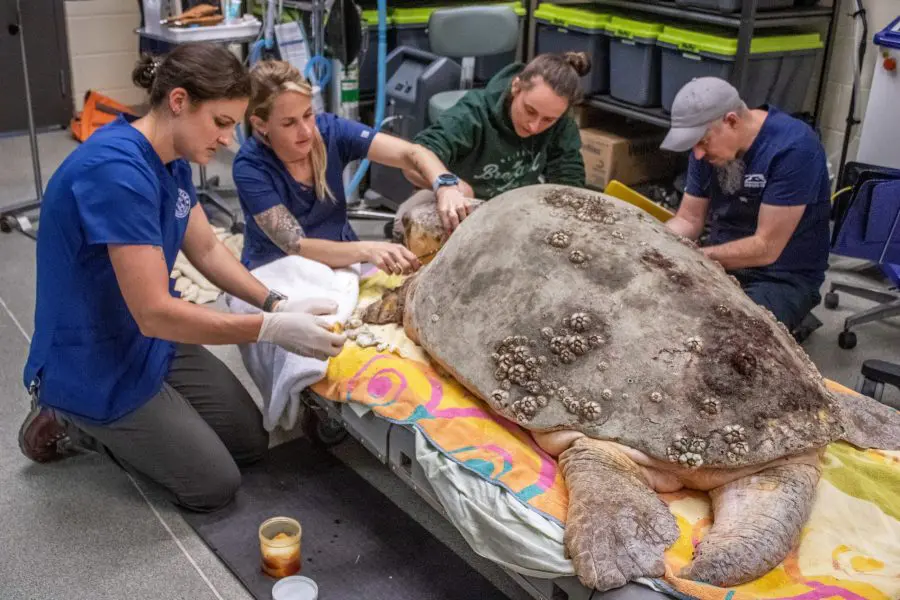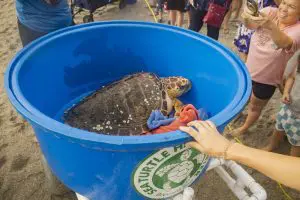

Bubba, like many of our patients, had lots of barnacles upon intake.
If you’ve been following the content surrounding our Sea Turtle Healing Center for some time, it’s likely you’ve noticed a few hitchhikers on our sea turtle patients’ backs. These clingy, shelled critters are barnacles!
Barnacles are a type of crustacean that lives a sedentary existence clinging to ocean life including – you guessed it – sea turtles! Most sea turtles, especially loggerhead turtles, will have barnacles hitching a ride. The barnacles seek out the stable surface of a sea turtle’s shell to help them avoid predation and secure food. However, this isn’t a symbiotic relationship, as sea turtles don’t directly benefit from the barnacle’s presence.
So, are barnacles harmful to sea turtles? This answer is…it depends!
“There are certain species of burrowing barnacles that can cause damage to a turtle’s skin and shell,” said Sea Turtle Healing Center Coordinator, Jess Patterson.
These barnacles can leave open wounds that, if left untreated, can often lead to infection. However, most barnacles are harmless to the everyday turtle. Chelonibia barnacles, also appropriately nicknamed the sea turtle barnacle, are typically the creatures you observe on the shells of our patients.
The good news is that this species of barnacle is usually benign. However, seeing a high volume of these barnacles on a sea turtle is often an indicator the turtle is in poor health.
“It is a sign that they are not moving as much and are not actively caring for themselves. That leaves an opening for opportunistic barnacles to attach and start growing,” noted Jess.

Loggerheads are more likely to have barnacles than green sea turtles.
The heavy weight from the encroaching barnacles can begin to interfere with the turtle’s swimming and range of motion. They can also grow over their eyes and nostrils, which can lead to serious problems. If this is the case, our veterinary staff will remove the barnacles necessary to help return the turtle to good health. We will also remove any barnacles that get in the way of diagnostic imaging.
It’s worth noting that improper removal of barnacles will do more harm than good. Poor removal will cause damage to the turtle’s skin and shell which can lead to infection.
If a sea turtle patient comes in with just a few chelonibia barnacles on their shell, our veterinary staff will leave them be. One reason for this is that barnacles hold an important role in our waterways! They are filter feeders, meaning they cleanse tiny debris from the water, and they serve as a food source and hiding space for certain marine species. Barnacles are also an indicator species, meaning they provide information about the environmental conditions in a particular area.
Barnacles can also help us identify a lot about a turtle’s history, like where they have been depending on the species that grows on them.
“Turtles that have been spending a lot of time out in the open ocean, away from the coastal areas, will grow gooseneck barnacles. This is expected if you get a small turtle, since that’s where they grow up, but if you get an adult with gooseneck barnacles, it raises questions,” said Jess.
Finally, our staff likes to keep in mind that barnacles are also living, breathing animals themself that just want to stick around!
“I like to think if sea turtles are endangered, that means the barnacles have less homes to land on,” said Jess. “I like to leave a few on each patient if they are not in an annoying location.”
Have you found a sea turtle that needs help? Visit this page or call the Sea Turtle Preservation Society at 321-206-0646. Want to help the Sea Turtle Healing Center? Support our Zoo, or view our Healing Center’s wishlist.